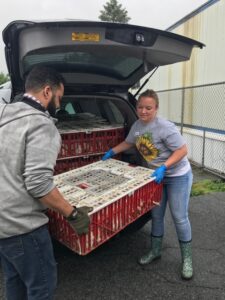Written by: Inga Fricke, Director of Community Initiatives, Humane Pennsylvania
If you care about animals like I do, I’m sure you’ve heard a fellow animal-lover proclaim “if people can’t afford a pet they shouldn’t have one!” Chances are you shared that sentiment. After all, seeing an animal succumb to a preventable disease or suffer with a treatable condition is heartbreaking, and makes us instinctively want to shield them from any circumstances that are likely to put them in harm’s way – and an easily identifiable, inherently “risky circumstance” for pets is the very fact that they are living with people in poverty.
But pets aren’t luxury items, like Bentleys or Birkin bags, reserved for only the privileged few who live in affluent communities. They are our constant companions, our protectors, our sources of unconditional love. They make sure we get our exercise, open doors to form connections with strangers we otherwise never would have met, and teach our children about empathy and caring for others. They are everything that’s good and pure about our lives – and they couldn’t care less what neighborhood we live in, whether we drive a car or use the bus, or how much take-home pay we have left at the end of the month.
There is no direct correlation between a person’s income level and the love and care they will provide for their pets. If that were the case, I would never have dealt with horrible animal neglect or abuses cases in middle-or upper-class neighborhoods – but I have. Nor would I have ever met amazing people living in dire personal circumstances who skip their necessary medications so they can afford to spay the stray cat who just showed up on their street, or who go without eating so they can ensure their pets stay well fed until their assistance check finally shows up – but I have. Money doesn’t stop some people from neglecting their pets, treating them like disposable commodities. And the lack of money doesn’t prevent people who
have almost nothing from doing all they can to put their pets’ needs first.

You might think “well that’s all well and good, but people still have a responsibility not to get a new pet if they know they will struggle to care for it.” Another well intentioned thought, but not necessarily reality. Most Americans are just one or two paychecks away from financial ruin – what would people say about you, as a pet owner, if you suddenly lost your job or were diagnosed with an illness that quickly drained away all your savings?
And something most of us don’t consider — very often the pets in the poorest homes are actually rescues, taken in after someone in the neighborhood passed away, lost their job, was evicted by their landlord, or found themselves unable to care for their animals for some reason. In fact, one program serving the poorest residents of Baltimore found that nearly ¾ of the pets living in those homes were acquired this way. The people who have protected them from a brief, brutal life on the streets are actually animal heroes – deserving of our praise, not our disdain.
If you still think that “’THEY” shouldn’t have pets, ask yourself – where is the cutoff? Should you be allowed to have a pet only if you make more than $50,000 a year? $75,000? $100,000? What if the clerk at the pet store notices you are feeding your cat Friskies, rather than a super-premium $80-a-bag prescription diet food — should you be placed on a “watch list”, flagging you as a potential “bad pet owner”? If you can’t spend $3,500 for laser treatment and aqua therapy for your arthritic dog, should he be immediately removed from your home and placed with an owner who can? Who will decide which homes are “worthy” of a pet and which aren’t? If the idea of someone else deciding whether or not you deserve to keep your pet feels icky and uncomfortable, that’s because it is! We all know that our love for our pets has nothing to do with what food we can afford to buy, or how many luxuries we can give them; the same is true for people who are living in our most underserved communities.
It is true that proper pet care costs money, there’s no doubt about that. But we can do more good for animals by putting our judgments aside and instead lending a hand in support. Humane Pennsylvania is doing just that; our new Community Outreach team is working hard every day to ensure that pet owners in our community can get the best possible care for their pet, regardless of their level of income, whether they have a car, or what language they speak. If they want to provide better care for their pets, we want to help them get it, no questions asked.
As animal lovers, we instinctively want to keep all animals out of harm’s way; the easiest way for us to do that is to stop judging the quality of pet owners by the size of their paychecks and instead look at the love they have in their hearts. By this measure, ours is easily one of the richest communities around!






